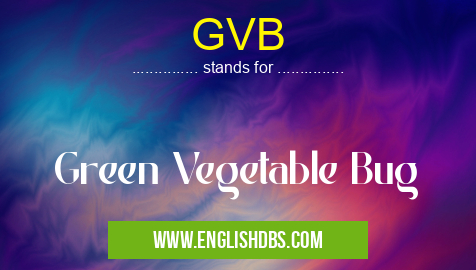What does GVB mean in UNCLASSIFIED
GVB stands for Green Vegetable Bug. It is a type of insect that belongs to the Pentatomidae family. These bugs are commonly found in gardens and agricultural fields, where they feed on a variety of plants.

GVB meaning in Unclassified in Miscellaneous
GVB mostly used in an acronym Unclassified in Category Miscellaneous that means Green Vegetable Bug
Shorthand: GVB,
Full Form: Green Vegetable Bug
For more information of "Green Vegetable Bug", see the section below.
What is a Green Vegetable Bug?
GVBs are relatively large insects with a shield-shaped body. They are typically green in color with dark markings on their wings. These bugs have piercing, sucking mouthparts that they use to extract plant juices from their host plants.
GVB Habits and Habitat
GVBs are active during the day and typically hide in the leaves or stems of plants. They are known to feed on a wide range of vegetables, including tomatoes, peppers, beans, and potatoes. GVBs can also be found feeding on weeds and other non-crop plants.
Impact on Plants
GVBs can cause significant damage to plants by feeding on their leaves and stems. This feeding activity can result in stunted growth, reduced yields, and even plant death in severe cases. The excrement of GVBs can also attract other pests and diseases, further harming plants.
Control Measures
There are several methods that can be used to control GVB populations:
- Cultural Practices: Crop rotation, sanitation, and weed control can help reduce GVB infestations.
- Biological Control: Natural enemies such as parasitic wasps and predatory insects can be introduced to help control GVBs.
- Chemical Control: Insecticides can be used to kill GVBs, but they should be used judiciously to avoid harm to beneficial insects.
Essential Questions and Answers on Green Vegetable Bug in "MISCELLANEOUS»UNFILED"
What is a Green Vegetable Bug (GVB)?
A Green Vegetable Bug (GVB), also known as Nezara viridula, is a species of stink bug that is commonly found in gardens and agricultural fields. They are known for their bright green color and distinctive shield-shaped body. GVBs are primarily herbivorous, feeding on a wide range of fruits, vegetables, and other plant matter.
What does a Green Vegetable Bug look like?
Green Vegetable Bugs are typically about 12-18 mm in length and have a shield-shaped body that is bright green in color. Their antennae and legs are black, and they have a distinctive white or yellow band around the edge of their abdomen. The nymphs (immature GVBs) are smaller and have a darker green color, with a series of black spots on their backs.
What does a Green Vegetable Bug eat?
Green Vegetable Bugs are primarily herbivorous, feeding on a wide range of fruits, vegetables, and other plant matter. Some of their favorite foods include beans, tomatoes, peppers, corn, and soybeans. They can also feed on flowers and leaves, and have been known to damage crops by sucking the sap from plants.
Where do Green Vegetable Bugs live?
Green Vegetable Bugs are found in a variety of habitats, including gardens, agricultural fields, and wooded areas. They are most common in warm, humid climates and can be found throughout the world. GVBs are typically active during the day and can be seen crawling on plants or flying from plant to plant.
Are Green Vegetable Bugs harmful to humans?
Green Vegetable Bugs are not typically harmful to humans. However, they can be a nuisance in gardens and agricultural fields, as they can damage crops by feeding on fruits and vegetables. They can also release a foul-smelling odor when they are disturbed, which can be unpleasant.
Final Words: GVBs are common pests that can cause significant damage to plants. By understanding their habits and implementing appropriate control measures, farmers and gardeners can minimize the impact of these insects on their crops.
GVB also stands for: |
|
| All stands for GVB |
